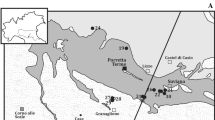Abstract
The Silurian Salina Group of the Michigan Basin consists of halite, carbonates, and shales. The halite was probably deposited when seawater became restricted over what is now southern Michigan. The halite consists of: (1) beds containing only chevrons, and (2) beds composed of chevron and cumulate crystals. This indicates shallow depositional waters. The primary fluid inclusions along growth bands in these crystals are well preserved and unaltered. These cubic, all-liquid inclusions, ranging in size from >1 to 150 μm, represent Silurian surface waters.
These all-liquid inclusions were cooled in order to nucleate a vapor bubble. After cooling, inclusions were warmed slowly and the homogenization of the vapor bubbles to liquid was observed. The homogenization temperatures ranged from 19.8°C to 59.0°C, with the majority of the measurements falling below 40.0°C. Validity of this temperature data is strongly suggested by: (1) reproducibility of homogenization temperatures within 1°C; and (2) similar homogenization temperatures within individual growth bands ranging between 4–10°C. Therefore, these homogenization temperatures represent Silurian shallow water temperatures.
In modern shallow evaporative settings, the water temperatures and the air temperatures are very similar. Since petrography of the halite beds indicates shallow water deposition, these homogenization temperatures may be good proxies for Silurian air temperatures.
This may be among the first quantitative Silurian climate data. Paleoclimate data such as these may give new insights into modern climate and future climate trends.
Similar content being viewed by others
References
AMZY, K., VEIZER, J., BASSETT, M., and COPPER, P., 1998, Oxygen and carbon isotopic composition of Silurian brachiopods: implications for coeval seawater and glaciations:Geological Society of America Bulletin, v. 110, p. 1499–1512.
BARNOLA, J. M., RAYNUND, D., KOROTKEVICH, Y.S., and LORIS, C., 1987, Vostok ice core provides 160,000 year record of CO2:Nature, v. 329, p. 408–413.
BENISON, K.C., 1995, Permian surface water temperatures from Nippewalla Group Halite:Carbonates and Evaporates, v. 10, p. 245–251.
BENISON, K.C. and GOLDSTEIN, R.H., 1999, Permian paleoclimate data from fluid inclusions in halite:Chemical Geology, v. 154, p. 113–132.
BROWN, C.B., 1995, Sedimentology, fluid inclusion geochemistry, and paleoclimate implications from a salt core of Badwater Basin, Death Valley, Califormia: unpublished Master’s Thesis, State University of New York at Binghamton, Binghamton, NY, 182p.
CARPELAN, L.H., 1958, The Salton Sea: physical and chemical characteristics:Limnology and Oceanography, v. 3, p. 373–386.
CASAS, E. and LOWENSTEIN, T.K., 1989, Diagenesis of saline pan halinte: comparison of petrographic features of Modem, Quaternary, and Permian halites:Journal of Sedimentary Petrology, v. 59, p. 724–739.
CASAS, E., LOWENSTEIN, T.K., SPENCER, R.J., and PENGXI, Z., 1992, Carnallite mineralization in he nonmarine, Quidam Basin, China: evidence for the early diagenetic origin of potash evaporites:Journal of Sedimentary Petrology, v. 62, p. 881–898.
CERCONE, K.R. and POLLACK, H.N., 1991, Thermal maturity of the Michigan Basin: Geological Society of America Special Papers, v. 256, p. 1–12.
DELLWIG, L., 1955, Origin of the Salina salt of Michigan:Journal of Sedimentary Petrology, v. 25, p. 83–110.
EUBANK, M.E. and BROUGH, R.C., 1980, The Great Salt Lake and its influence on weather:Utah Geological and Mineral Survey Bulletin, v. 116.
EUGESTER, H.P., 1970, Chemistry and origin of the brines of Lake Magadi, Kenya: Mineralogical Society of America Special Paper 3, p. 213–235.
EVERHAM, W. and HUNTOON, J., 1999, Thermal history of a deep well in the Michigan Basin; implications for a complex burial history: Geothermics in Basin Analysis, p. 177–202.
GOLDSTEIN, R.H. and REYNOLDS, T.J., 1994, Systematics of fluid inclusions in diagenetic minerals: SEPM (Society for Sedimentary Geology) Short Course 31, Tulsa Oklahoma, 199p.
GORNITZ, V.M. and SCHREIBER, B.C., 1981, Displacive halite hoppers from the Dead Sea: some implications for ancient evaporite deposits:Journal of Sedimentary Petrology, v. 51, p. 787–794.
LEIBOLD, A., 1992, Sedimentology and geochemical constraints on Niagara/ Salina deposition, Michigan Basin: unpublished Ph. D Dissertation, University of Michigan, p. 280.
LORIUS, C., JOUZEL, J., RAYNAUND, D., HANSEN, J., and LE TREUT, H., 1990, The ice core record: climate sensitivity and future greenhouse warming:Nature, v. 347, p. 139–145.
LOWENSTEIN, T.K. and HARDIE, L.A., 1985, Late Quaternary chronology of tufa deposits, Walker Lake, Nevada:Journal of Geology, v. 96, p. 417–433.
PETRICHENKO, I.O., 1979, methods of study of inclusions in minerals of saline deposits:Fluid Inclusion Research, v. 12, p. 214–274.
ROBERTS, S.M. and SPENCER, R.J., 1995. Paleoclimate preserved in fluid inclusions in halite:Geochimica et Cosmochimica Acta, v. 59, p. 3929–3942.
ROEDDER, E., 1984, Fluid Inclusions. Mineralogical Society of America:Reviews in Mineralogy, v. 12, 644 p.
SEARS, S.O. and LUCIA, F.J., 1979, Reef-growth model for Silurian pinnacle reefs, northern Michigan reef trend:Geology, v. 7, p. 299–302.
SONNENFELD, P. and AL-AASM, I., 1991, The Salina evaporites in the Michigan Basin: Geological Society of America Special Papers, v. 256, p. 139–154.
Author information
Authors and Affiliations
Rights and permissions
About this article
Cite this article
Losey, A.B., Benison, K.C. Silurian paleoclimate data from fluid inclusions in the Salina Group halite Michigan Basin. Carbonates Evaporites 15, 28–36 (2000). https://doi.org/10.1007/BF03175646
Received:
Accepted:
Published:
Issue Date:
DOI: https://doi.org/10.1007/BF03175646




